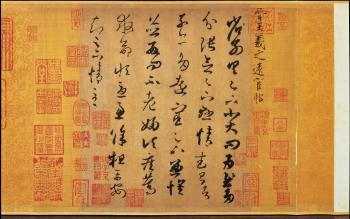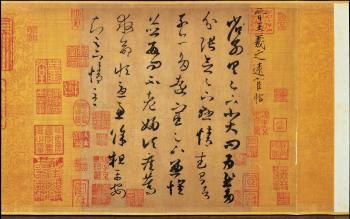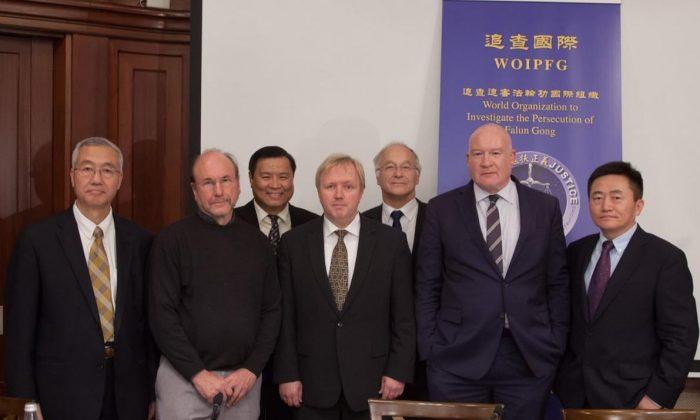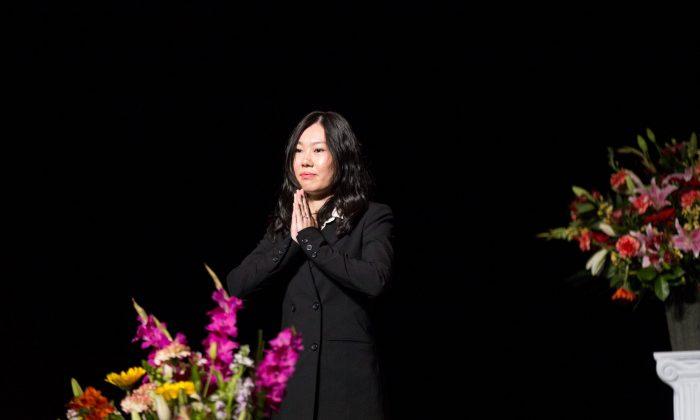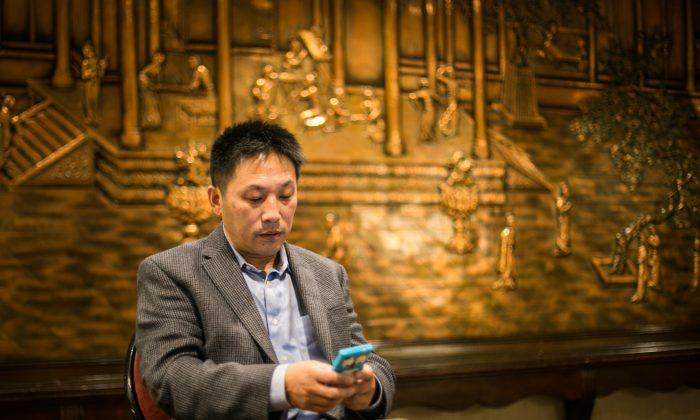TAIPEI—The master calligrapher Ch‘ing Yu-kuo’s thick brush snapped and slid across the paper, leaving mysterious symbols of lampblack ink known as the Chinese characters. His creations followed the melody of the flautist, to his side, who was playing the famous “Orchid Spring” on a bamboo dizi. Their work was completed in minutes, and Ch’ing stepped back to reveal a ten character motif of good wishes: “Following the grand tradition, a lofty realm and great wisdom will be our future destiny.” Members of the press and VIPs promptly erupted in emphatic applause.
Taiwan’s world renowned National Palace Museum (NPM) celebrated its 83rd anniversary on October 8. Joining the celebration was current director, Chou Kung-shin, who took the occasion to outline her ambitious plans to lead the museum into the future, and used the opportunity to open and introduce two of the museum’s striking new exhibitions.
The first, Stunning Decorative Porcelains from the Chienlung Reign, is a showcase of magnificent porcelain craftsmanship mostly from the mid 18th century, under the Qianlong Emperor of the Qing dynasty. The second, Masterpieces of Chin and T'ang Dynasty Calligraphy, presents quintessential calligraphy from the Eastern Jin (317-420 CE) and Tang (618-907 CE) periods, with several other influential pieces.
Taiwan’s world renowned National Palace Museum (NPM) celebrated its 83rd anniversary on October 8. Joining the celebration was current director, Chou Kung-shin, who took the occasion to outline her ambitious plans to lead the museum into the future, and used the opportunity to open and introduce two of the museum’s striking new exhibitions.
The first, Stunning Decorative Porcelains from the Chienlung Reign, is a showcase of magnificent porcelain craftsmanship mostly from the mid 18th century, under the Qianlong Emperor of the Qing dynasty. The second, Masterpieces of Chin and T'ang Dynasty Calligraphy, presents quintessential calligraphy from the Eastern Jin (317-420 CE) and Tang (618-907 CE) periods, with several other influential pieces.
The porcelains are a fascinating example of the Qianlong Emperor’s (1711-1799 CE) “vibrancy and confidence” in the early years of his 60-year reign, the museum’s website says. The majority of the over 100 works on display represent yang cai porcelains, so named because they incorporate a variety of Western influenced elements in their exquisite decoration, such as Western flowers, shading, and perspective. The term “yang” in Chinese refers to the “ocean,” and is extended to mean anything foreign, or from the West.
Behind their creation was the supervisor of the imperial kilns, Tang Ying, who was personally requested by the emperor to oversee the production of the wares in spring and autumn each year. During this process he conceived an endless series of innovations for the pleasure of the emperor, such as the “flower brocade pattern,” which is a technique of incised decoration, inclusions of his own poetry on the pieces, stamps, and imperial seals, calling them yang cai. Others later admired the porcelains as “work of the Gods.”
The NPM offers extensive descriptions of the complex techniques associated with their creation on their website.
The Masterpieces of Chin and T'ang Dynasty Calligraphy exhibition also stands as a powerful example of the wealth of ancient Chinese culture. Several of the most valuable pieces on display are Tang-era reproductions of the works of Wang Xizhi (303-361 CE), who is regarded as the Sage of Calligraphy.
Chinese calligraphy encompasses various distinct scripts, which are set forms for writing the characters developed over Chinese history. Wang is famous both for his fusion of several major script styles, and for his rendition of the ideal forms of the regular, running and cursive scripts. Writers of the austere Tang dynasty, when the meticulous reproductions of his works were made, praised him for “bringing the best methods together to form a style of his own to become a master for all ages.” The Tang reproductions now stand as the best remaining examples of his works, as all originals have been lost.
One of Wang’s works featured in the exhibition, Timely Clearing after Snowfall, is a short letter written in semi-regular script, where Wang greets his friend after a snowfall. The Palace Museum says that “judging from the strokes, this work indeed mainly reveals the use of a rounded and blunt brush, with none of the dots and hooks revealing the brush tip, creating an overall even and steady form.” They say this “elegant manner … reveals a simple and introverted harmony.” The Qianlong Emperor praised this particular work as “alone under the Heavens, a rare match with the ancient today.” Wang’s works were taken by later generations as models of ideal calligraphy, and are still widely studied.
Other works come from the Tang dynasty by calligraphers who “hold seminal positions in the pantheon of Chinese calligraphy,” according to the Taipei Times. He Yan-chuan, assistant curator of the exhibition, told the Times that the display is significant because it encompasses a large portion of the extant calligraphy from this period, and it is the first time that so many of these foundational works have been on display together at the museum.
Hundreds of visitors now shuffle past the dimly lit scrolls and shining porcelains daily, examining them carefully and exchanging their observations in hushed whispers. In late November they will be shut away, according to museum regulations, not to emerge again for another two years.



